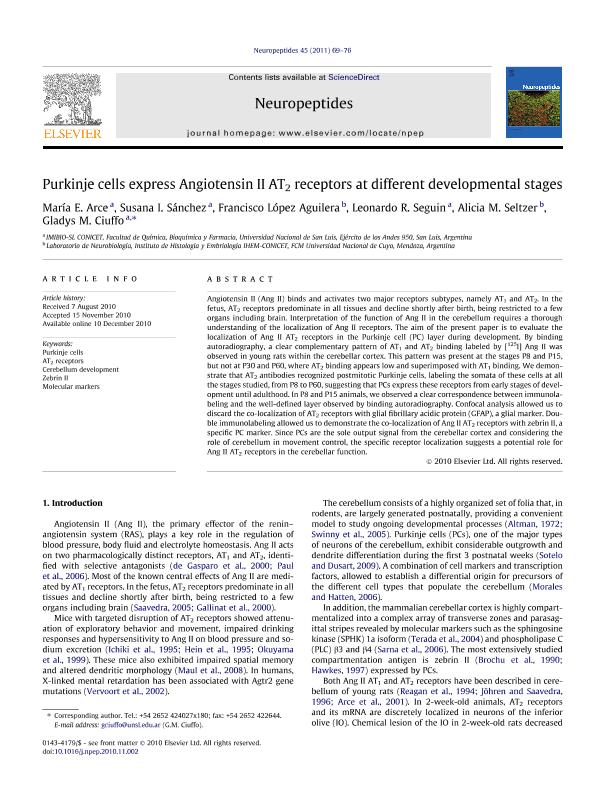Mostrar el registro sencillo del ítem
dc.contributor.author
Arce, María E.
dc.contributor.author
Sánchez, Susana I.
dc.contributor.author
Lopez Aguilera, Francisco Roberto

dc.contributor.author
Seguin, Leonardo Roque

dc.contributor.author
Seltzer, Alicia Mabel

dc.contributor.author
Ciuffo, Gladys Maria

dc.date.available
2017-04-03T18:23:52Z
dc.date.issued
2011-02
dc.identifier.citation
Arce, María E.; Sánchez, Susana I.; Lopez Aguilera, Francisco Roberto; Seguin, Leonardo Roque; Seltzer, Alicia Mabel; et al.; Purkinje cells express Angiotensin II AT2 receptors at different developmental stages; Elsevier; Neuropeptides; 45; 1; 2-2011; 69-76
dc.identifier.issn
0143-4179
dc.identifier.uri
http://hdl.handle.net/11336/14708
dc.description.abstract
Angiotensin II (Ang II) binds and activates two major receptors subtypes, namely AT1 and AT2. In the fetus, AT2 receptors predominate in all tissues and decline shortly after birth, being restricted to a few organs including brain. Interpretation of the function of Ang II in the cerebellum requires a thorough understanding of the localization of Ang II receptors. The aim of the present paper is to evaluate the localization of Ang II AT2 receptors in the Purkinje cell (PC) layer during development. By binding autoradiography, a clear complementary pattern of AT1 and AT2 binding labeled by [125I] Ang II was observed in young rats within the cerebellar cortex. This pattern was present at the stages P8 and P15, but not at P30 and P60, where AT2 binding appears low and superimposed with AT1 binding. We demonstrate that AT2 antibodies recognized postmitotic Purkinje cells, labeling the somata of these cells at all the stages studied, from P8 to P60, suggesting that PCs express these receptors from early stages of development until adulthood. In P8 and P15 animals, we observed a clear correspondence between immunolabeling and the well-defined layer observed by binding autoradiography. Confocal analysis allowed us to discard the co-localization of AT2 receptors with glial fibrillary acidic protein (GFAP), a glial marker. Double immunolabeling allowed us to demonstrate the co-localization of Ang II AT2 receptors with zebrin II, a specific PC marker. Since PCs are the sole output signal from the cerebellar cortex and considering the role of cerebellum in movement control, the specific receptor localization suggests a potential role for Ang II AT2 receptors in the cerebellar function.
dc.format
application/pdf
dc.language.iso
eng
dc.publisher
Elsevier

dc.rights
info:eu-repo/semantics/openAccess
dc.rights.uri
https://creativecommons.org/licenses/by-nc-nd/2.5/ar/
dc.subject
Purkinje Cells
dc.subject
At2 Receptors
dc.subject
Cerebellum Development
dc.subject
Zebrin Ii
dc.subject
Molecular Markers
dc.subject.classification
Bioquímica y Biología Molecular

dc.subject.classification
Ciencias Biológicas

dc.subject.classification
CIENCIAS NATURALES Y EXACTAS

dc.title
Purkinje cells express Angiotensin II AT2 receptors at different developmental stages
dc.type
info:eu-repo/semantics/article
dc.type
info:ar-repo/semantics/artículo
dc.type
info:eu-repo/semantics/publishedVersion
dc.date.updated
2017-03-30T17:42:33Z
dc.journal.volume
45
dc.journal.number
1
dc.journal.pagination
69-76
dc.journal.pais
Países Bajos

dc.journal.ciudad
Ámsterdam
dc.description.fil
Fil: Arce, María E.. Universidad Nacional de San Luis. Facultad de Química, Bioquímica y Farmacia; Argentina. Consejo Nacional de Investigaciones Científicas y Técnicas. Centro Científico Tecnológico San Luis. Instituto Multidisciplinario de Investigaciones Biológicas de San Luis; Argentina
dc.description.fil
Fil: Sánchez, Susana I.. Consejo Nacional de Investigaciones Científicas y Técnicas. Centro Científico Tecnológico San Luis. Instituto Multidisciplinario de Investigaciones Biológicas de San Luis; Argentina. Universidad Nacional de San Luis. Facultad de Química, Bioquímica y Farmacia; Argentina
dc.description.fil
Fil: Lopez Aguilera, Francisco Roberto. Consejo Nacional de Investigaciones Científicas y Tecnicas. Centro Cientifico Tecnologico Mendoza. Instituto Histologia y Embriologia de Mendoza "Dr. M. Burgos"; Argentina. Universidad Nacional de Cuyo; Argentina
dc.description.fil
Fil: Seguin, Leonardo Roque. Consejo Nacional de Investigaciones Científicas y Técnicas. Centro Científico Tecnológico San Luis. Instituto Multidisciplinario de Investigaciones Biológicas de San Luis; Argentina. Universidad Nacional de San Luis. Facultad de Química, Bioquímica y Farmacia; Argentina
dc.description.fil
Fil: Seltzer, Alicia Mabel. Consejo Nacional de Investigaciones Científicas y Tecnicas. Centro Cientifico Tecnologico Mendoza. Instituto Histologia y Embriologia de Mendoza "Dr. M. Burgos"; Argentina. Universidad Nacional de Cuyo; Argentina
dc.description.fil
Fil: Ciuffo, Gladys Maria. Consejo Nacional de Investigaciones Científicas y Técnicas. Centro Científico Tecnológico San Luis. Instituto Multidisciplinario de Investigaciones Biológicas de San Luis; Argentina. Universidad Nacional de San Luis. Facultad de Química, Bioquímica y Farmacia; Argentina
dc.journal.title
Neuropeptides

dc.relation.alternativeid
info:eu-repo/semantics/altIdentifier/url/http://www.sciencedirect.com/science/article/pii/S0143417910001113
dc.relation.alternativeid
info:eu-repo/semantics/altIdentifier/doi/http://dx.doi.org/10.1016/j.npep.2010.11.002
Archivos asociados
